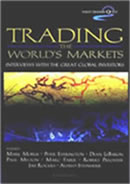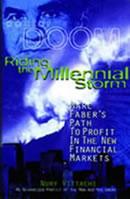

By Leo Gough
John Wiley & Sons
ISBN: 0471838616
Book Description
See how new investment professionals are already shaping the next millennium Twenty-first-century investors are a more sophisticated and better informed breed due to the tremendous amount of detailed and up-to-date information they demand on a regular basis. Trading the World Markets provides serious equity investors with a host of ideas and insights about the world markets drawn from the leading international stock market players themselves—from fund managers, analysts, and traders to professional speculators, CEOs, and investment bankers. Leo Gough is an investment author and journalist who has written twelve books, including How the Stock Market Really Works and 25 Investment Classics: Insights from the Greatest Investment Books of All Time. This book is for investors who want to make above-average returns. Shows you how to become a global investor. Interviews with Mark Mobius, Jim Rogers, Marc Faber, Peter Everington, and Paul Melton included.
Editorial Review: Amazon.com
Most people who've caught the investment bug and have any common sense should know success is never as easy as it seems, despite the markets' furious rise in the past few years. And only the most foolish and naive of do-it-yourself investors would pass up the chance to learn from those who've been successful in the past. Leo Gough's Trading the World Markets features eight great global investors, several of whom have already been featured in other books: one, the eccentric motorbiker Jim Rogers (a former partner of George Soros), was featured in the second of John Train's books. Two others, the emerging-markets expert Mark Mobius and the Hong Kong-based professional doomster Marc Faber, seem to have been in every book and magazine published on investment.
The whole point about books like this is not to discover specific investment ideas but rather to learn more about the mental and intellectual disciplines needed to sustain a record of winning investments. There are some stimulating and interesting bits here. Two of the most pertinent pieces of advice are currently being widely ignored. The first is: "Most of the time the best thing that you can do is do nothing ... look out of the window, go to the movies, drink beer". In other words, only invest when you are reasonably confident you know why and what you are buying. The second is directed at the Internet: "Just because an industry changes the world, it doesn't mean you are going to make any money if you buy that industry at the wrong time in the frenzy".
All in all, the book's general advice points in the opposite direction of which most investors are currently headed. In the years to come, it may look quite prescient; as Sir John Templeton first pointed out, the only sure-fire way to make money in the stock market is to do something that most other people already are not. --Jonathan Davis

by Nuri Vittachi
John Wiley & Sons
ISBN: 0471832057
Book Description
First-hand information about Dr. Doom's financial predictions for the millennium. Dr. Marc Faber, a.k.a. Dr. Doom, offers here his financial ideas, theories, and predictions for the forthcoming millennium. Written by the ever entertaining and brilliant Nury Vittachi, this book offers a fascinating and unique insight into the eccentric world of Faber, the financial guru extraordinaire. The book also features a detailed portrait of Faber, the man, including insights into the unconventional way Faber conducts his research, his background, and his history of his winning and losing predictions. Marc Faber, PhD (Hong Kong) is an investment advisor and publisher of the "Gloom, Boom, and Doom" Reports. Nury Vittachi (Hong Kong) is one of Asia's most popular writers and speakers.
Synopsis
Dr Marc Faber, a.k.a. "Dr Doom", is a Hong Kong based investment adviser. He has been warning Asia for many years of its impending financial crisis, now that this crisis is reality, his views are more in demand than ever. This text looks at Faber's life in Asia and his predictions for the forthcoming millennium. In this text Nury Vittachi offers an insight into Faber's background, including his history, his winners and losers and the unconventional way that he conducts his research. The result is a detailed portrait of "Dr Doom" - who he is and how he came to be in his present position.
From the Inside Flap
"The book, Riding the Millennial Storm, is entertaining, highly readable and most important, provides an understanding of how Marc Faber, one of the great financial and investment minds in the world today, analyzes the major trends in the financial markets and economies of the world. Dr Faber always provided his readers and clients with insights into the futures which are grounded in historical understanding, healthy scepticism for the investment fads and manias of the day an accurate knowledge. Such knowledge is derived from his own research into what is rally going on below the surface. This book is most timely now that the global investment mania, which Dr Faber predicted, has ended. Investors who refuse to heed his warning will continue to pay a heavy price."
- J. Anthony Boeckh chairman & Editor-In-Chief The Bank Credit Analyst Research Group
"You will learn an enormous amount from Marc Faber - whether you agree with him or not!"
- Jim Rogers, author of Investment Biker
"One does not go to see Marc Faber, Hong Kong's iconoclastic share pundit, in the expectation of good news. But after listening to him, no investor could claim he had not been warned. For Faber, a blunt-spoken Swiss, says the things nobody want to hear..."
- The Sunday Times (London)
"(Faber) is the region's (Asia's) most notorious bear."
- The Wall Street Journal
"(Faber) is something of an icon."
- The Financial Times of London
"Marc Faber, congential contrarian and shrewd Swiss investment advisor..."
- Fortune
From the Back Cover
Meet Dr Doom. If there are two sides to every coin then Dr Faber is almost always on the other side. Famous for his contrarian approach to investing, Marc Faber does not run with the bulls or bait the bears but steers his own course through the maelstrom of international finance markets. In 1987 he warned his clients to cash out before Black Monday in Wall Street; he made them handsome profits by forecasting the burst in the Japanese Bubble in 1990; he correctly predicted the collapse in US gaming stocks in 1993; and he foresaw the Asia-Pacific financial crisis of 1997/98 and the resulting global volatility. Now Dr Faber has re-drawn his map of the world and sees the approach of a period of global financial restructuring that will transform the established world order. In this original and entertaining read, Asia's leading satirist Nury Vittachi, profiles the Swiss-born investment guru, reviews his spectacular successes (and equally spectacular failures) and details his complex view of the next twenty years - a time when investors will be on an exhilarating rollercoaster ride to a barely recognizable world.
"Marc Faber is one of the most creative and original thinkers in the financial world. A fabulous book!"
- Baron M. Biggs Chairman, Morgan Stanley Asset Management, Inc.
"I love Marc Faber. He is a thoughtful contrarian with a historical perspective. He doesn't fit the conventional mould, which is why he is successful. Long may his ponytail wave."
- Robert R. Prechter, Jr. President, Elliot Wave International
Includes
◾ How major economic waves signal a red alert at the end of the 1990s
◾ Where to look for safe investment sin an uncertain world
◾ Faber's Dark Side Theorem: The inevitability of wealth destruction and its invisibility testing testing testing testing testing testing testing testing testing testing testing testing testing testing testing testing testing testing testing testing
◾ Why rock-solid investment winners are losers
◾ How Shanghai will become wealthier then New York
◾ Vital lessons form the stalled growth in Japan
◾ How technology is increasing, not decreasing the dangers of investing
About the Author
Nury Vittachi is one of Asia's best known writers. He has written 10 books, and produces at least 150 newspaper columns a year. Originally a refugee from the civil war in Sri-Lanka, he now lives in Hong Kong with his English wife and tow adopted Chines children.
REVIEW columnist Nury Vittachi's new book is a profile of Marc Faber, an eccentric gadfly, historian and financial adviser based in Hong Kong. Faber is known as 'Doctor Doom' for his predictions of a global economic meltdown.
Conference appearances by Marc Faber are often followed by animated discussions between confused reporters. They know that the Hong Kong based investment advisor has become an economic icon. They have press clippings in which he is called The Prince of Pessimism or The Godfather of Gloom. But that doesn't really gel with what they have just seen - an investment analyst with a somewhat chequered career whose enthusiastic words conjure up a bright future for some of the world's poorer countries, and who is confident that his advice can preserve the wealth of those who listen to him.
The press have tried to simplify him, and to simplify is necessarily to mislead. In fact, neither Faber nor his theories are particularly pessimistic. Whence does this contradiction arise? Perhaps the fundamental train of thought behind his investment philosophy is best summed up by his favourite anecdote:
It's a bitterly cold day. You have lost all feeling in your nose. Your ears are hurting. You hunch your shoulders together to bury your head under the raised lapels of your greatcoat. You turn a corner and you see a frozen pond. Can you risk taking a short cut across? Or would it be safer to walk to the bridge half a mile down the road? You notice a man on the other side of the pond. He gingerly steps on to it. It holds the weight of one foot. He carefully places the other foot on the ice. A young woman behind follows his lead. As you watch, some children arrive with skates, and more adults follow them. Soon, the whole village is having a party on the ice. Each person has given the next person the confidence to join the party. The more people clambering on to the ice, the safer it feels. It's logical, isn't it? Or is it? Something makes you stop. You turn around. You walk away. Behind you, you bear the crack and the first scream.
That is Mare Faber's vision. Yes, you could say it is a dark vision, but it does the opposite of what most sunglasses do. Instead of increasing obscurity, it introduces clarity. As an increasing number of heavy bodies add themselves to the ice, human nature makes them feel the safety factor is increasing. But the clear-thinking observer realizes that their added weight means that the opposite is true. Each fresh body on the ice makes it more - not less - likely that the ice will crack. The global investment business today is a business in exactly the same way as the street market in Camden Town or Bangkok is. It is manned by salespeople who all have products they want you to buy. They make sure that what they sell is attractive. They tell you uplifting stories of how buyers of their services have generated wealth for themselves. They attract you to the ice ...
. . .It's 2 a.m. on a Friday in Hong Kong and the U.S. market is having a good day. It's May, 1996, and the Dow Jones is floating upward like a helium balloon. FM Select 104 is churning out "Don't Worry, Be Happy." Faber is in his office, absently humming "Everything is Beautiful." He is sitting at his word processor waiting for some inspiration for his newsletter....
Earlier that evening (or first break period, considering Faber's 24-hour schedule) he had been chatting with this reporter about the creed of the mom-and-pop investor. Their Ten Commandments go something like this:
Ready to get started?
